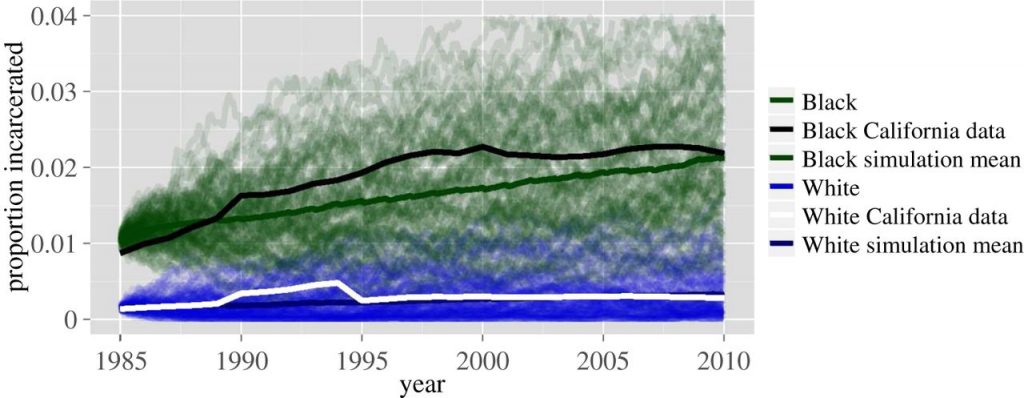Researchers have noted that, for decades, prison sentences have been just ever-so-slightly more harsh for black people than white people.
As a whole, these findings undermine the so-called ‘‘no discrimination thesis’’ which contends that once adequate controls for other factors, especially legal factors (i.e., criminal history and severity of current offense), are controlled unwarranted racial disparity disappears. In contrast to the no discrimination thesis, the current research found that independent of other measured factors, on average African-Americans were sentenced more harshly than whites. The observed differences between whites and African Americans generally were small, suggesting that discrimination in the sentencing stage is not the primary cause of the overrepresentation of African-Americans in U.S. correctional facilities.
Mitchell, Ojmarrh. “A meta-analysis of race and sentencing research: Explaining the inconsistencies.” Journal of Quantitative Criminology 21.4 (2005): 439-466.
Not as widely noted: incarceration sorta behaves like a contagious disease.
First, an individual’s incarceration can increase the family members’ emotional and economic stress, and cumulative strains are related to criminal behaviour. Specifically, it has been shown that the children of incarcerated parents tend to display increased levels of behaviour issues, including aggressive behaviour, a predictor of criminality in later life. Close family members, such as the inmates’ domestic partners, experience the acute effects of their family member’s incarceration. Decreased household income due to the inmate’s inability to work while incarcerated and the inability of the inmate to contribute to child care responsibilities put the remaining family members at increased risk of work–family conflicts, stress and depression. Economic losses within the household further percolate to the next generation. Economic and social mobility data show that children born into low income households to parents with low education are themselves more likely to have low levels of educational attainment and to earn a relatively low income in adulthood. These are, of course, risk factors for incarceration, thus reinitiating the incarceration–poverty cycle in a new generation.
Kristian Lum, Samarth Swarup, Stephen Eubank, James Hawdon. “The contagious nature of imprisonment: an agent-based model to explain racial disparities in incarceration rates.” J. R. Soc. Interface 2014 11 20140409; DOI: 10.1098/rsif.2014.0409. Published 25 June 2014
So Lum et. al decided to combine both observations: what happens to incarceration rates over time, if we treat incarceration as an infection? They whipped up an agent-based model based on real-world data, and treated both white and black people the same except for that tiny difference in prison sentences. Even the fraction of the population incarcerated was balanced across race. After letting the model fly repeatedly, they gathered up the pieces.
The white prison population decreased at first, but then gently rose over time. The black prison population, in contrast, grew rapidly at first and less rapidly later on. At the end of the simulation, the fraction of black people incarcerated had, on average, ballooned to seven times the equivalent white proportion. Scarily enough, that’s in the ballpark of real-world differences.
See MARC MAUER, THE RACE TO INCARCERATE 139 (1999) (“African Americans, therefore, have a seven times greater chance of being incarcerated than do whites.”); Becky Pettit & Bruce Western, Mass Imprisonment and the Life Course: Race and Class Inequality in U.S. Incarceration, 69 AM. SOC. REV. 151, 152–53 (2004) (discussing data that suggest that “blacks are punitively policed, prosecuted, and sentenced”). Pettit and Western also provide a detailed analysis, using data from 1974 to 1999, to demonstrate that the incarceration rate of black males is approximately ten times that of white males. Id. at 156–58; William J. Sabol, Heather C. West & Matthew Cooper, Bureau of Justice Statistics, Prisoners in 2008 8, tbl.8 (2009), http://bjs.ojp.usdoj.gov/content/pub/pdf/p08.pdf (demonstrating an average annual increase of 2.5% in the U.S. prison and jail population).
Sabol, West & Cooper, supra note 174, at 2 (stating that “[b]lack males were incarcerated at a rate six and a half times higher than white males” in 2008).
Main, Matthew P. “Promoting Self-Sufficiency-How HRA’s Exclusion of Incarceration from the Definition of Temporary Absence Contradicts Statutory Mandates and Hurts New York Families.” CUNY L. Rev. 14 (2010): 105.
Naturally, results this good should raise red flags. The “incarceration as infection” metaphor is woefully simplistic, it doesn’t even account for public policy like the “War on Drugs!” So the researchers tossed another test at their model: what happens when you start off with actual incarceration rates, instead of equality?
You get back good approximations of real-world data. Save that five-year blip, the white prison population follows the model almost exactly; the percentage of black inmates rises above the average trend, but stays remarkably close to the average trend given said “war” was being waged. Lum et. al also pitted their model against prisoner demographic data, and again got an eerie match. That meta-analysis up top got it wrong: these small differences in sentencing can explain much larger differences in incarceration!
Bigotry can follow the butterfly effect: small acts of discrimination can accumulate to create big differences in outcomes. Even when the discrimination is slight (a recent study estimated the gap was almost five months), even when all races were otherwise treated equally by the justice system (unlike real life), substantial injustice can accumulate. The same effect also applies to segregation, wealth, and even harassment swarms and microaggressions.
If you’ve ever wondered why the social justice crowd keeps banging on about seemingly “trivial” biases, this is your answer.

